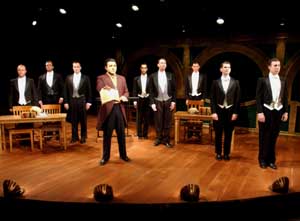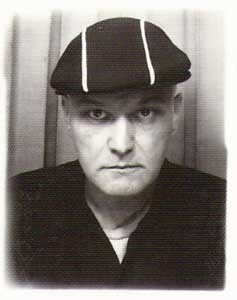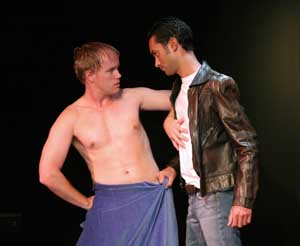Arts & Entertainment
Diversionary Theatre’s 20th anniversary
Published Thursday, 01-Sep-2005 in issue 923
Another page of gay history is being written as Diversionary Theatre marks its 20th anniversary this year. Let the gay, lesbian, bisexual and transgender community celebrate together by continuing to support this noble institution’s goal: telling our story while providing a home and venue for the remarkable talents of San Diego’s theater professionals.
Diversionary Theatre’s mission statement is to produce plays with GLBT themes that portray characters in their complexity and diversity, both historically and contemporarily. And so they have, and so they do, and so they will continue to do.
It started with a young man by the name of Tom Vegh who had come to San Diego to attend San Diego State University in 1984. Tom was studying language pathology, even taking a class from a former professor by the name of Pat Launer – one of San Diego’s best-loved theater critics, who is often referred to as “the diva.”
I sat down with Vegh recently at the Living Room Coffee Shop for a cup of java while he collected his thoughts about the early days of Diversionary Theatre. Some of his recollections had grown vague with the passage of time, but many remained crystal clear, as if they had happened just last week.
Gay & Lesbian Times: Can you remember the exact moment when Diversionary Theatre took wing?
Tom Vegh: I can’t recall an exact date, but I do recall two events that triggered the birth of what would be called Diversionary Theatre. I was a student at SDSU and I was appalled at the lack of knowledge on campus about AIDS. I began to raise money to import a show from San Francisco that had played at the Theatre Rhinoceros called Artists Involved in Death and Survival. It was a huge success and, post show, offered answers about AIDS from health care professionals as well as individuals living with the AIDS virus. That was the first event. The second event was a fund-raiser that I spearheaded. The money raised from this event would be used to fight the proposed passage of Proposition 64, initiated by [Lyndon] LaRouche, which would have allowed for the quarantine of AIDS victims in Borrego Springs, complete with barbed wire. We presented a musical called Fortune in a discotheque as part of the fund-raising efforts.
GLT: Would you say that these two incidences were the springboard for what is now proudly referred to as Diversionary Theatre?
TV: Yes. These events, which included local San Diego opinion leaders like Brad Truax, Nicole [Murray-Ramirez], Terry Driscoll and others, demonstrated that there was an audience for gay theater. I found the community was “hungry to banquet.”
It was in 1986 that Vegh offered two Philip Real plays called Lunch and Dessert at the West Coast Production Company, which had an unprecedented, successful six-week run.
Most concur that this presentation marked the birth of Diversionary Theatre.
GLT: It looks like you were the whole theatrical Diversionary shebang: producer, actor, director.
TV: I secured the papers for the incorporation of our non-profit organization and began writing grants. We received monies from the San Diego’s Transient Occupancy Tax, the Liberty Hill Foundation, California Arts Council and the San Diego Commission on Arts and Culture. From there we put up what we could afford, often begging set pieces from other theaters and costumes from anyone who might lend us a helping hand.
Vegh talks of various angels that helped with the early years of Diversionary with great fondness. They included individuals like Kit Goldman (Gaslamp Theater) and even institutions like SDSU, who rented period costumes to Diversionary at reasonable rates.
GLT: How long did it take for Diversionary Theatre to get noticed?
TV: Almost immediately. I remember that one of our first productions, Charles Ludlum’s Stage Blood, was given a “best show in town” by critic Jonathan Saville. Additional support was given [to] the theater by others such as Christine Kehoe, who was then a gay editor working for publisher Michael Portantino.
GLT: When and why did you bid adieu to Diversionary?
TV: I think it was early 1989, after Stage Blood was presented at the Balboa Park Puppet Theatre. I was exhausted from the stress of having to wear the daunting hats of director, actor, as well as producer. It took a toll on me and created a wound that has played an open-ended run in my life. I’m just now approaching resolve.
GLT: Now that you’re back in San Diego after a long hiatus in the San Francisco area, would you like to participate once again with the theater?
TV: I long for an opportunity to return to rehearsal; I love that process.
We might not have Diversionary operating today without Vegh’s perseverance in mounting those initial six plays, three readings and two fund-raisers. Vegh continues to believe that whatever looming issue raises its ugly head, artists are there first to combat the demon. As for Tom himself, he says simply and directly, “God has a plan.”
Diversionary Theatre has been at its present location on Park Boulevard for over a decade. Previous homes included the Golden Hills Neighborhood Center, the Sushi Gallery, San Diego Rep Sixth Avenue Playhouse, the Roosevelt Theatre and even the Marie Hitchcock Puppet Theatre in Balboa Park. But no matter where Diversionary has hung its hat, our community has continued to support the gay theater.
Along the way, there have been many successes. Along the way their have been many in agreement so that our community could have a viable gay theater. Along the way, Diversionary Theatre has always triumphed against all the odds.
Without the help of past executive directors like Robert Joseph, Chuck Zito, Neil Rothschild, Gayle Feldman and so many others, we wouldn’t be looking forward to the 2005-06 season at Diversionary. And without staunch board members like Larry Oviatt, Susan Atkins and Jonathan Dunn Rankin, Diversionary wouldn’t be what it is today. Without actors, directors and technicians who were willing to pool their talents and energies and offer their valuable time, Diversionary wouldn’t exist.
I looked at the lists of plays from seasons past and I remain astonished at the work that has been done – many of the productions have been acknowledged over the years for their excellence. I’m sure many readers have their favorites. Here are some of mine:
Boys in the Band, by Mart Crowley and directed by Tim Irving
Lot’s Daughters, by Rebecca Basham and directed by Rosina Reynolds
Our Gay Apparel, written and directed by Robert Joseph
Never the Sinner, by John Logan
Jeffrey, by Paul Rudnick and directed by Tim Irving
Bent, by Martin Sherman and directed by Ruff Yeager
Angels in America, by Tony Kushner
Fit to be Tied, by Nicky Silver
Looking For Normal, by Jane Anderson
Stopping by Diversionary Theatre, I had an opportunity to speak to newly appointed executive director Dan Kirsch. Here’s what he had to say about the current state of affairs at the theater.
Gay & Lesbian Times: What do you think is the main role of Diversionary Theatre in the community at large?
Dan Kirsch: I believe it is to provide [that] our core audience [is] entertained and satisfied, while at the same time, welcoming others into our theater. I think we have arrived at a time where old is new again, so we are ready to try anything and everything again.
GLT: Is there any room in Diversionary’s mission statement to produce non-gay productions?
DK: The mission statement allows for Diversionary to produce plays about the lesbian, gay, bisexual and transgender lifestyles. It also affords us the opportunity to present plays by gay playwrights such as Tony Kushner, as we have done this season with his A Bright Room Called Day.
GLT: Do you feel that the past directors have any ownership within the Diversionary organization?
DK: Many of them have “a feel of ownership.” They should feel extremely proud of the part they played in making Diversionary what it is today and I very much respect their unique contributions.
GLT: Do you have any special events planned to mark the 20th anniversary of Diversionary Theatre?
DK: Yes. We plan to celebrate over an extended period of time. The party even includes a guest visit by past executive director Chuck Zito, who will return to do a reading of his first novel that will be published in the near future. Other events will include retrospectives by various groups like the Gay Men’s Chorus and dramatic presentations by three UCSD alumni that will highlight moments from our theatrical past.
GLT: What are you doing differently from your predecessors?
DK: From a financial perspective, we are attempting to expand our season subscriptions, but we are also reaching out to special groups of individuals so that we can offer them group rates [GSBDA, SAGE, Gay Men’s Chorus Night and Front Runners among them].
GLT: You are also sharing your space with another theater company, correct?
DK: We have invited Moxie Theatre Company to share our space between our regular season for 2005-06. This partnering allows for the theater to introduce our space to others who may never have visited us before. It is hoped that once these new visitors find their way to Diversionary Theatre, they will return often. Another new theater company called Mo’olelo will also participate with us to a smaller extent.
Diversionary Theatre is also reaching out to the community by offering their space to various benefit nights, such as the one for Actors Alliance performers who were headed to the Minnesota Fringe Festival this summer. Monday nights are no longer dark, as they are offering off-nights for such shows as the recent The Paul Lynde Show and the San Diego Actors Theater production of Simply Shakespeare. It seems their current mantra is loud and clear: Let no day go by without theater activity at Diversionary.
GLT: Your 2005-06 season looks quite exciting. Would you like to tell us about it?
DK: Our first production in September is called Valhalla. It’s by Paul Rudnick, who authored Jeffrey, about a mad king and a Texas teenager who find out the price to be paid for getting everything you’ve ever dreamed of. Tony Kushner’s A Bright Room Called Day is our second production of the season. In January we will offer Jonathan Harvey’s Beautiful Thing, about two young London teens in love. March will have Rosina Reynolds directing The Twilight of the Golds by Jonathan Tolins, and our final production is Patricia Kane’s Pulp, the Musical, a comedy and homage to the lesbian pulp fiction of the 1950s.
GLT: You’ve got some pretty impressive directors and actors already on the boards for the 2005-06 season.
DK: Yes, Tim Irving will direct Valhalla, followed by Brendon Fox, Rosina Reynolds and Delicia Turner Sonnenberg [one of the four founders of Moxie Theatre Company]. Some of the actors already committed for the season include Priscilla Allen, Ron Choularton, Jessica John and Daren Scott.
GLT: What’s your vision for Diversionary?
DK: My vision rests upon quality work and perhaps some new plays. We want to continue with some learning opportunities as well, such as what we did with Normal where we conducted intimate “talk backs” about the transgendered community after several of the shows.
The paver that marks the entrance into Diversionary Theatre, penned by P. M. Katcher, reads, simply and to the point, “There Must Be GLBT Theater.” With visionary individuals like Kirsch and a very supportive managing director, Bret Young, the next 20 years can only spell out continued success and continued entertainment for the entire GLBT community.
Many people involved in Diversionary Theatre have come and gone, but many have stayed on to continue with its success and development. Let’s hope the talent pool will continue to enrich San Diego’s gay theater, and that we will all continue to profit from the rich resources that help us understand ourselves a little better. Diversionary Theatre highlights
1986: Birth of Diversionary Theatre
1987: 501c3 non-profit status granted
1988: Grants received from COMBO, the San Diego community and the Liberty Hall Foundation. Drama presented about AIDS (Life of the Party). Tom Vegh resigns
1989: First show at the Golden Hill Neighborhood Outreach Center. First all-woman show
1990: Fiscal receiver for AIDS Art Alive
1991-92: Union Tribune Critics Choice (Ten Percent Revue)
1992: 10-year lease signed for space at 4545 Park Blvd. First reprise (Ten Percent Revue)
1993: The city of San Diego approves plans for Diversionary Theatre; permits issued
1994: Diversionary Theatre receives final approval for occupancy
1994: Opening night, March 3, proclamation by Mayor Susan Golding: “Diversionary Theatre Day,” Councilmember Christine Kehoe attends
What the critics say
I asked Pat Launer, one of San Diego’s best theater critics, to contribute a testimonial about her many years reviewing Diversionary Theatre and this is what she penned:
“Twenty years of Diversionary! It’s been a wild roller coaster ride – from exhilarating highs – Porcelain (1994), Angels in America, Part I (1999), Love! Valour! Compassion! (1997 and 2003), Lot’s Daughters (2001), Jeffrey (2001), Breaking the Code (2001), The Boys in the Band (2001), Never the Sinner (2002), to some puerile, prurient lows (that are better left unmentioned).
“The ups and downs were typically dictated by the artistic or executive director du jour. There have been breakups and make-ups over the years. But at its best, Diversionary has been provocative and ebullient. Executive director Dan Kirsch is a great new addition, and the upcoming season, with its bevy of high-profile, high-powered guest directors, looks extremely promising. When Diversionary does ‘gay plays,’ it often falters; when it does good, or even great plays that happen to have gay themes or characters, it soars. Onward and upward, in the decades to come!”
Another of San Diego’s best loved critics, Welton Jones, said, “Everything about Diversionary Theatre is modest, except its success.”
|
|
Copyright © 2003-2025 Uptown Publications






